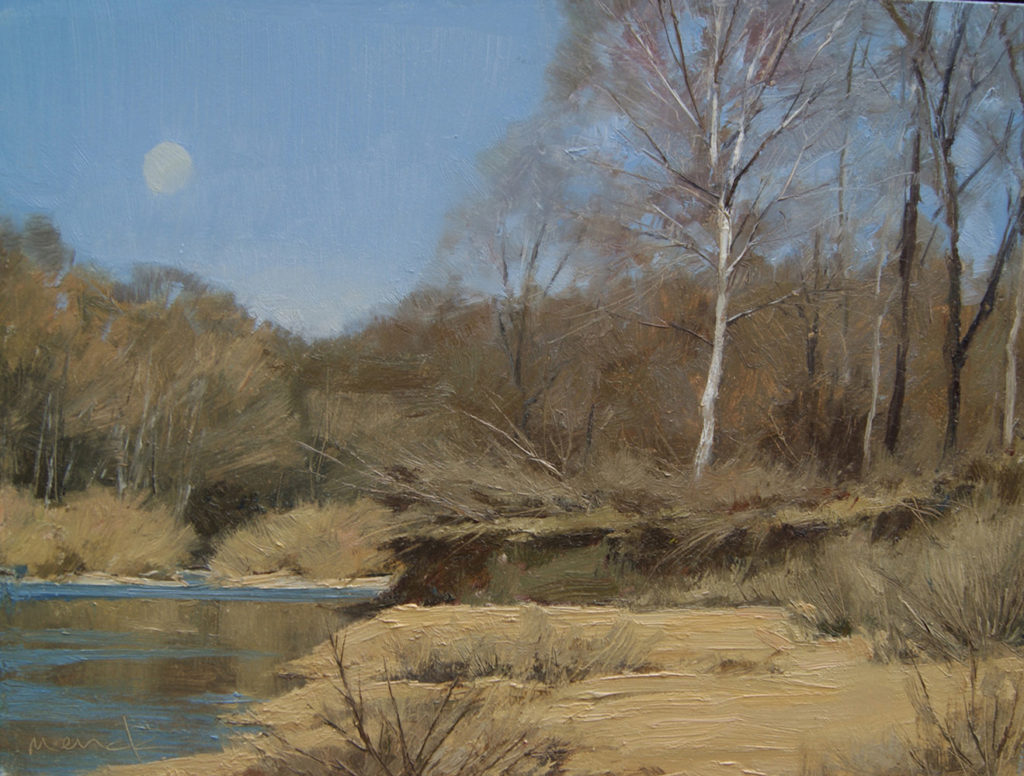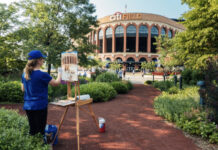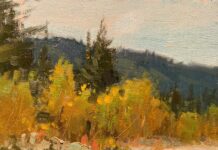Painting landscapes sounds easy enough if you’re coming from an artistic background, right? Maybe not so much…Kevin Menck explains.
Nature’s Student
BY KEVIN MENCK
I think the one thing that has impacted my work the most is my time afield. If I had one piece of advice it would be to study nature.
My artistic journey began as a graphic designer, and then continued for sixteen years as an illustrator. I never considered a career as a fine artist until I met and befriended a painter named Jason Saunders. Jason taught me the importance of painting from nature, to paint en plein air. At that point, I became a plein air painter.
Having been an avid outdoorsman for years, I saw it as a way to combine my art with my love of the outdoors and the landscape. I honestly thought that because I was an illustrator and had knowledge of the landscape, I would be able to just step outside and start cranking out these wonderful landscape paintings. Little did I know how difficult it would be and how little I actually knew.

My artistic training began in art school where I was given a classical art training education. I was taught subjects such as figure drawing, value studies, painting the head and figure from life, and color theory, among others. After graduation, I became a designer, where I didn’t necessarily use my classical art training on a daily basis.
Shortly after that, I gravitated to the field of illustration. There my education was used to a degree, but not in the context of painting or fine art. Once I decided to become a fine artist, I had to dust off the things I had been taught in art school and that I had picked up from other artists, and try to apply them after years of not using those skills. The results were disastrous.
My first two or three years of painting landscapes were an unbelievable struggle of trying to understand value, color, paint applications, composition, etc. It wasn’t until I began to understand value and began to see masses and big shapes and the value of each as they related to each other that my paintings began to look like something that actually resembled the landscapes I saw outside.

It is these relationships of value that give the landscape its structure. There is a great book by John Carlson called “Carlson’s Guide to Landscape Painting” (1973), which explains a lot of these value relationships—about what creates values in the landscape and how they relate to each other.
I remember early in my painting career, having gone out and painted with Jason Saunders, I came in with what I thought to be a really dynamite little landscape painting. I set it down and began admiring it. Jason soon set his next to mine and in that instant I had one of those epiphanies that we all have from time to time that impacts our careers. I immediately saw the orchestration of value in his masses and how they were correct in their relationships to each other.

From that day forward, a lot of things became much clearer to me. That’s not to say I began to paint like a master, by any stretch of the imagination, but now I had an understanding that would allow me to see my paintings differently. I could now see why some paintings worked, why some didn’t work; in other words, I could evaluate my mistakes.
Up to that point, I had been painting landscapes without truly understanding what I was trying to accomplish, about what constituted a good, sound painting. Now I had something I could use as a foundation to begin to learn to orchestrate a painting.

The next big step for me as a landscape painter was slowly learning to see color temperatures as they relate to each other. This is something I still struggle with. But again, once I started getting my head around it a bit, it made a huge difference in my work and has had a tremendous impact on how I perceive “color.”
When I began painting outdoors, I tried to pare down my supplies to a bare minimum. Trying to haul tons of gear into the field wasn’t practical. I keep it pretty simple out there: one type brush, small panels (usually 9×12), and the three-color palette. Less is better. Through a very organic process and having gone through a ton of palette choices, the three-color palette seems to work best for me and my work: Cadmium Scarlet, Cadmium Lemon and Ultramarine Blue.
When I mix my paint, there are two questions I ask myself: “Is it lighter or darker?” and “Is it warmer or cooler?” I’m looking for the right values and the right temperature. I ask myself these two questions each and every time I mix color for a passage. I compare it to tuning a guitar string. I mix and work in that puddle of paint until I hit the note. I apply it, and then start the next note.

In my journey as an artist, I have been exposed to some incredible artists and have had some very talented teachers along the way. But I think none has been as influential as Mother Nature. Without doubt, Mother Nature has been the best of all teachers.
Early on it was instilled in me to paint from nature and that is what I set out to do when I began. It has had a huge impact on the work I do, the scenes I paint and where it has led my career. Don’t get me wrong. I studio paint and I do work from photos. But the things I learn from being out of doors greatly influence my interpretation in the studio. When I teach, I stress to my students the importance in learning from direct observation, painting landscapes directly from nature, in whatever subject they take up. I believe it is absolutely vital.

I don’t recall who originally said, “The more you learn about painting, the harder it gets,” but I could not agree more. The more I learn, the less I know.
I have no idea what epiphanies I will have next, whose work will influence mine the most, or what my work will look like in ten years. Nothing is certain I suppose, except that we all likely agree that being an artist is an extraordinary journey.
Connect with Kevin Menck at www.kevinmenck.com.
Visit EricRhoads.com to find out all the amazing opportunities for artists through Streamline Publishing, including:
– Online art conferences such as Plein Air Live
– New video workshops for artists
– Incredible art retreats for painting landscapes en plein air
– Educational and fun art conventions, and much more.
> Subscribe to Plein Air Today, a free newsletter for artists
> Subscribe to PleinAir Magazine so you never miss an issue






My wife and I are so honored to have one of Kevin’s plein air landscapes as well as one of Jason Saunders (which we found in one of our favorite galleries on Leipers Fork, south of Nashville). So imagine our surprise and delight to see this article by Kevin which also referenced Jason’s influence on his work! Very nice!
loved it